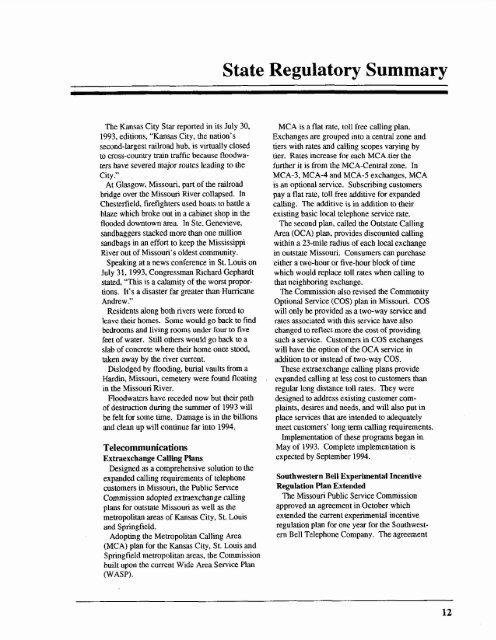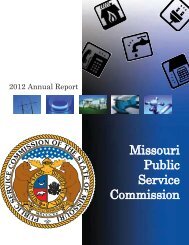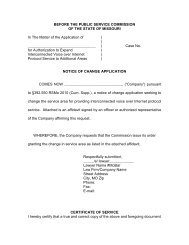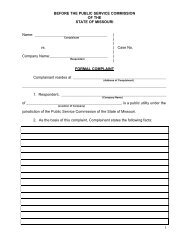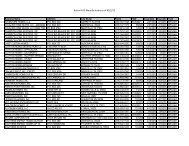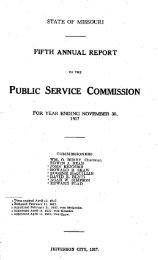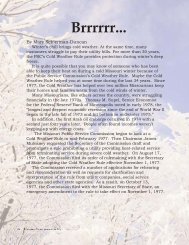1993 PSC Annual Report - Missouri Public Service Commission
1993 PSC Annual Report - Missouri Public Service Commission
1993 PSC Annual Report - Missouri Public Service Commission
You also want an ePaper? Increase the reach of your titles
YUMPU automatically turns print PDFs into web optimized ePapers that Google loves.
The Kansas City Star reported in its July 30,<br />
<strong>1993</strong>, editions, "Kansas City, the nation's<br />
second-largest railroad hub, is virtually closed<br />
to cross-country train traffic because floodwaters<br />
have severed major routes leading to Ibe<br />
City."<br />
At Glasgow. <strong>Missouri</strong>, part of the railroad<br />
bridge over the <strong>Missouri</strong> River collapsed. In<br />
Chesterfield, firefighters used boats to battle a<br />
blaze which broke out in a cabinet shop in the<br />
flooded downtown area. In Ste. Genevieve,<br />
sandbaggers Slacked more than one million<br />
sandbags in an effort to keep the Mississippi<br />
River out of <strong>Missouri</strong>'s oldest community.<br />
Speaking at a news conference in St. Louis on<br />
July 31. <strong>1993</strong>, Congressman Richard Gephardt<br />
stated. "This is a calamity of the worst proportions.<br />
It's a disaster far greater than Hurricane<br />
Andrew."<br />
Residents along both rivers were forced to<br />
leave their homes. Some would go back to find<br />
bedrooms and living rooms under four to five<br />
feet of water. Still others would go back to a<br />
slab of concrete where their home once stood,<br />
taken away by the river current.<br />
Dislodged by flooding, burial vaults from a<br />
Hardin, <strong>Missouri</strong>, cemetery were found floating<br />
in the <strong>Missouri</strong> River.<br />
Floodwaters have receded now but their path<br />
of destruction during the summer of <strong>1993</strong> will<br />
be felt for some time. Damage is in the billions<br />
and clean up will continue far into 1994.<br />
Telecommunications<br />
Extraexchange Calling Plans<br />
Designed as a comprehensive solution to the<br />
expanded calling requirements of telephone<br />
customers in <strong>Missouri</strong>, the <strong>Public</strong> <strong>Service</strong><br />
<strong>Commission</strong> adopted extraexcbange calling<br />
plans for outstate <strong>Missouri</strong> as well as the<br />
metropolitan areas of Kansas City, St. Louis<br />
and Springfield.<br />
Adopting the Metropolitan Calling Area<br />
(MCA) plan for the Kansas City, St. Louis and<br />
Springfield metropolitan areas, the <strong>Commission</strong><br />
built upon the current Wide Area <strong>Service</strong> Plan<br />
(WASP).<br />
State Regulatory Summary<br />
MCA is a flat rate, toll free calling plan.<br />
Exchanges are grouped into a central zone and<br />
tiers with rates and calling scopes varying by<br />
tier. Rates increase for each MCA.tier the<br />
further it is from the MCA-Central zone. In<br />
MCA-3, MCA-4 and MCA-5 exchanges, MCA<br />
is an optional service. Subscribing customers<br />
pay a flat rate, toll free additive for expanded<br />
calling. The additive is in addition to their<br />
existing basic local telephone service rate.<br />
The second plan, called the Outstate Calling<br />
Area (DCA) plan, provides discounted calling<br />
within a 23-mile radius of each local exchange<br />
in outstate <strong>Missouri</strong>. Consumers can purchase<br />
either a two-hour or five-hour block of time<br />
which would replace toll rates when calling to<br />
that neighboring exchange.<br />
The <strong>Commission</strong> also revised the Community<br />
Optional <strong>Service</strong> (COS) plan in <strong>Missouri</strong>. COS<br />
will only be provided as a two-way service and<br />
rates associated with this service have also<br />
changed to reflect more the cost of providing<br />
such a service. Customers in COS exchanges<br />
will have the option of the DCA service in<br />
addition to or instead of two-way COS.<br />
These extraexchange calling plans provide<br />
expanded calling at less cost to customers than<br />
regular long distance loll rates. They were<br />
designed to address existing customer complaints,<br />
desires and needs, and will also put in<br />
place services that are intended to adequately<br />
meet customers' long term calling requirements.<br />
Implementation of these programs began in.<br />
May of <strong>1993</strong>. Complete implementation is<br />
expected by September 1994.<br />
Southwestern Bell Experimental Incentive<br />
Regulation Plan Extended<br />
The <strong>Missouri</strong> <strong>Public</strong> <strong>Service</strong> <strong>Commission</strong><br />
approved an agreement in October which<br />
extended the current experimental incentive<br />
regulation plan for one year for the Southwestern<br />
Bell Telephone Company. The agreement<br />
12


